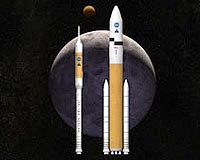 |
Cape Canaveral, Florida (AFP) July 12, 2009 Forty years ago, mankind's most daunting frontier was boldly overcome when Neil Armstrong became the first man to walk on the moon, establishing America's dominance in the space race. At the height of the Cold War, Armstrong's "small step" onto the lunar surface was a giant slap in the face to the Soviet Union, which had been the first to put a satellite into orbit, and fly a man into space. Yet in the decades since the historic July 20, 1969 moon landing, few have followed in Armstrong's footsteps. Only 12 men have ever walked on the moon, all of them Americans, with the last lunar walks in 1972. The Apollo program, launched during slain president John F. Kennedy's administration, has long since been axed after six successful lunar landings. Now the hopes of American scientists for further manned moon missions lie with the Constellation program, which aims to put people back on the moon by 2020 and establish lunar colonies to use as launchpads to Mars. "It's mankind's destiny to walk on another planet. We can achieve it, but we've got to have the right plan," astronaut Buzz Aldrin, the second man to walk on the moon following Armstrong out of their capsule, told AFP. Future space exploration and the colonization of the solar system "is a pathway to establishing an alternate survival location for the human race," he said. "At some point, a maturing Earth society should take the necessary steps to ensure its survival, the survival of the contributions of humanity over thousands and thousands of years in the past and the opportunities in the future." Now potential rivals such as China seek to challenge US dominance in space, and some see the new space race as once again a battle between ideologies. "From the point of view of the future of the western world and its Asian allies it's imperative that the US, Europe, Japan, Australia, Canada and other like-minded countries be competitive in deep space," moonwalker and geologist Harrison Schmitt told AFP. Schmitt said he believed that "non-democratic nations of the world, China, Russia and maybe others, fully intend to be dominant in space... (and) gain that kind of prestige, that kind of advantage in technology and education and other fields that come with being the dominant space power. "With the Apollo program we taught them how," said Schmitt, who was the last astronaut to step out of a lunar craft and onto the moon surface in 1972. The Apollo program was launched in 1961 when Kennedy threw down a bold challenge to Congress to put a man on the moon within the decade. "I believe that this nation should commit itself to achieving the goal, before this decade is out, of landing a man on the moon and returning him safely to the Earth," Kennedy said. The decision to shoot for the moon was above all a political one, said John Logsdon, curator and expert at the National Air and Space Museum. The Soviet Union had put a satellite into orbit in 1957 with the launch of the Sputnik, and in 1961 Yuri Gagarin became the first man to fly in space. "The Soviet Union had defined space achievement the measure of power and desirability of a modern society and president Kennedy decided that leaving a dramatic space achievement only to the USSR was not in the US interest," Logsdon said. The Apollo program initially hit some setbacks. In 1967, three astronauts were killed in an accident on the ground. Then in December 1968, Apollo 8 blasted off, and America's first manned flight around the moon took place. Six months later it was followed by Apollo 10, a lunar reconnaissance trip with three astronauts on board. Then on July 16, 1969, Armstrong, the mission commander, Aldrin and Mike Collins were launched into orbit on the Apollo 11, which was taken up into space perched on the Saturn V rocket. Four days later, Aldrin manually maneuvered the lunar lander, dubbed "Eagle," to land on the moon's Sea of Tranquility. "Houston, Tranquility Base here. The Eagle has landed," he told mission control in Houston, Texas. At 10:50 pm (0250 GMT), the 38-year-old Armstrong left the module and stepped down a short ladder, landing on the moon's surface at 10:56pm and 48 seconds (0256 GMT). "That's one small step for man, one giant leap for mankind," Armstrong said, in a message relayed back to hundreds of millions watching and listening to the historic moment. Twenty minutes later he was joined by the 39-year-old Aldrin. And mankind's dreams of reaching for the stars had become a reality. Share This Article With Planet Earth
Related Links Space Tourism, Space Transport and Space Exploration News
 US manned space flight in doubt 40 years after moon walk
US manned space flight in doubt 40 years after moon walkCape Canaveral, Florida (AFP) July 12, 2009 US ambitions to send astronauts back to the moon, as a prelude to future Mars missions, have been put in doubt by budgetary constraints, 40 years after man's triumphant first lunar landing. After the Columbia space shuttle disaster in 2003, former president George W. Bush decided to phase out shuttle flights by 2010 and set a more ambitious space mandate for America. Launched in 2004 ... read more |
|
| The content herein, unless otherwise known to be public domain, are Copyright 1995-2009 - SpaceDaily. AFP and UPI Wire Stories are copyright Agence France-Presse and United Press International. ESA Portal Reports are copyright European Space Agency. All NASA sourced material is public domain. Additional copyrights may apply in whole or part to other bona fide parties. Advertising does not imply endorsement,agreement or approval of any opinions, statements or information provided by SpaceDaily on any Web page published or hosted by SpaceDaily. Privacy Statement |